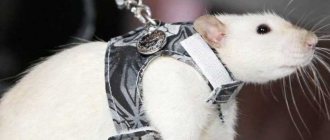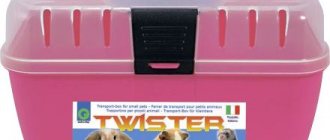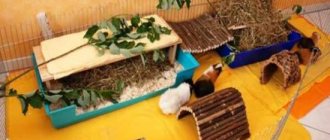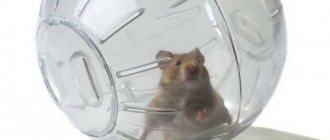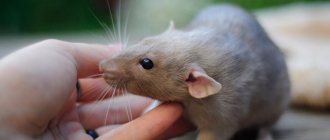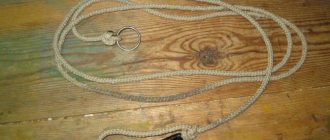As soon as warm days begin, hamster owners seriously think about how to provide their pet with a walk. Taking the cage outside, buying a leash for the hamster, arranging a special pen for it, or otherwise diversifying the pet’s life are questions that many lovers of these rodents think about.
What is a harness for?
A rat harness is a special device in the form of a leash, which is attached not to a collar, but to a belt system or vest. The natural instincts of rodents force them, in the event of even the slightest danger, to run away and hide in secluded places. This is why the process of walking a pet becomes a real problem for the owner. To protect yourself from losing your rat during a walk and to control its movement, experts advise using a harness. In addition, such a device serves as fall insurance if the pet is in your arms or on your shoulder.
It should be noted that not all rodents are able to easily respond to the presence of a leash. Many of them will not be able to adapt to the new accessory. Due to the characteristics of the rat’s body, the fragility of the joints, the structure of the shoulders and natural resourcefulness, the pet is able to quickly get rid of any type of harness. However, there are individuals who happily accept the innovation and calmly walk with a leash. As a rule, these are sedentary, reserved and “phlegmatic” male rats who quickly get used to the new device.
Important! You should accustom your rodent to a harness only when the pet is calm and quiet. In case of any manifestations of aggression, it is necessary to immediately release him from the leash.
Accessories for walking
Walking balls have long gained popularity among hamster owners, but there are other devices that can be used for walking your pet. However, more often these things are bought for decorative purposes to dress up your pet.
In addition to the special ball, there are the following accessories for walking:
- Leashes for hamsters. They are a tiny collar to which a long bright cord is attached. Naturally, you cannot walk a homa by squeezing its throat. After all, there is a risk of breaking the animal’s spine if the animal suddenly twitches. Also, compression of the neck leads to attacks of suffocation. Therefore, a collar with a ribbon is a purely decorative accessory.
- Harnesses for hamsters. A simple design, similar to a lace tied with a butterfly. The animal's paws are threaded through the loops; they also support its tummy. A small carabiner with a leash is attached to the upper crosspiece of the harness. Sometimes harnesses are sold as a vest. This accessory does not put pressure on the animal's neck, so it is great for walking.
These accessories are made from genuine leather, substitute or soft fabric. Leashes are decorated with beads, beads and rhinestones. Carbines come in plastic and metal.
Nursery of decorative rats, Moscow
You can find rat harnesses . Is it necessary?
I can immediately say that buying a rat harness is money thrown away. The first and main reason for this is the unique structure of the rat’s skeleton, thanks to which it can twist out of any position. Plus, a rat can simply chew it through.
In addition, it is almost impossible to put a harness on a rat correctly. If you tighten it a little more, the rat may simply refuse to walk and fall over on its side. And if you weaken it a little, the rat will run away before you even have time to blink an eye. There are rats that move perfectly on a harness . But usually these are calm individuals who, even without it, will not leave their owner even a single step. A harness can be useful in two cases:
- It can be put on a rat that sits on your shoulder while walking. The harness will not interfere with her in such a situation, but will help catch the rat in case of a fall.
- For beauty. A rat on a harness will look very impressive in photographs, at performances and competitions... The rat will last three minutes, and you will have time to appear in all your glory.
Whether to buy a harness or not is your choice. But you shouldn’t expect real benefits from it.
Curious pets, decorative rats love to walk, exploring new territories with curiosity and examining everything around them. A rat harness will ensure a safe walk around the house, yard or along the street. What it should be like, how to make it with your own hands, this article tells.
Clothing, leashes and harnesses for chinchillas
The accessories for chinchillas presented in stores today are so diverse that they confuse breeders. The most controversial product is the leash with harness. It is strictly forbidden to walk chinchillas on the street. And there are several reasons for this:
- Chinchilla fur is easily damaged by any harness or collar,
- Chinchillas don't walk - they move by jumping. A collar can break your spine, a harness can break your ribs,
- There are quite a lot of dangerous bacteria, microbes, fungi,
- A sudden change of environment, new smells and sounds, bright light - all this will lead to very strong stress and can provoke a heart attack.
- A chinchilla is usually walked at home, but for home walks a harness and leash are not needed.
- In the same way, leashes and harnesses are not needed for exhibitions - the animal is placed from the carrier into the exhibition box.
Products for chinchillas include a variety of clothes: vests, jackets, shorts, overalls and dresses. There is no need to talk about the actual use of such accessories: you cannot leave an animal in clothes in a cage - in a few minutes the pet will chew everything it can reach and also get poisoned by the dyed fabric. At exhibitions, animals also do not need additional decorations. The downside is that the chinchilla is a freedom-loving animal, and it can be very difficult to persuade the animal to wear clothing that restricts movement.
It is also worth remembering that the animal’s fur is quite dense and warm, which means you can get heat stroke from wearing clothes, especially in the summer months.
How to make a homemade harness for your pet
To walk with an animal and not lose sight of it, you need a harness. This design is a leash attached not to a collar, but to a vest or strap system. They are very expensive in pet stores; you can make a harness for your pet with your own hands.
Results
A rat on a leash looks interesting and elegant. You need to accustom her to such walks first indoors, then in deserted places outdoors. Until you are completely sure that the rat feels good in a harness, you should not go for a walk with it in the park. Even in this case, you need to be careful so that other animals do not attack your pet, or that it does not fall under the wheels of a bicycle or car. It is necessary to ensure that all locks on the harness are securely fastened.
Necessary materials
Today, pet stores offer a wide range of models of harnesses for rodents. They are practical, functional, made from various high-quality materials, but their main disadvantage is their high cost. For this reason, many breeders prefer to make their own leash.
Before you start creating a product, you should understand what types there are:
- From straps. These harnesses have a simple design and can be adjusted to fit the size of your pet. The straps under the rat's limbs encircle its torso and neck, and along the line of the belly and back there are straps that connect the entire product. To make such a leash, scraps of genuine leather and braided cords are usually used. Both latches and buckles are suitable as locks.
- Velcro. This design is mainly made in the form of a vest with fasteners located under the chest. A ring is attached at the bottom of the backrest, designed to secure the harness. Basically, leashes are made of durable, elastic nylon, which is conveniently and securely fixed to the rodent, preventing it from freeing itself and running away.
For home production, the first option is considered the simplest option.
During the sewing process, materials such as thick cord made of dense fabric or strips of durable fabric can be used. You can make a product from leatherette or genuine leather, but in this case you will need special tools to work with this type of material. Did you know? According to scientists, there are twice as many rats on planet Earth as there are people.
As fasteners, it is allowed to use small metal buckles or plastic fasteners, which are sold in any sewing store. You can use small buttons or buttons, but putting this harness on your pet will be extremely inconvenient and difficult. Of course, in the process of sewing a product you will need a pattern.
The simplest version of the pattern is shown in the photo below:
Where:
- a: 0.5–1 cm;
- c: width of the rat’s body behind the forelimbs;
- c: required interval between ring b and d;
- d: rodent neck volume;
- g, h: latches, for example, Velcro, which are sewn on both sides of the harness;
- e: a clasp, which can be used as a paper clip, or a carabiner from a mobile phone.
If you want to develop a pattern yourself, it is recommended to take the following measurements from your pet:
- neck girth;
- girth of the body behind the forelimbs;
- the interval between the two previous marks.
Main varieties
It is not recommended to buy a collar for a rat - it is inconvenient and dangerous to use. If the collar is not fastened tightly, the animal will turn out, and if the strap is tightened, there is a high risk of accidentally strangling the pet. Harnesses are much safer because the load is evenly distributed on the animal’s body. Two types of harnesses are common.
From straps
It has a simple design that is conveniently adjustable to fit the size of the rat. The straps wrap around the animal's neck and torso under the paws, and connecting straps run along the belly and back. Such harnesses can be made of various materials - braided cords, leather. Both buckles and latches are used as locks.
Velcro
Usually it has the form of a vest, which is fastened under the animal’s chest. A ring is sewn on the lower part of the back of the product for attaching a leash. These harnesses, made of stretchy nylon, are usually very comfortable and securely hold the animal in place, reducing the chance of it getting its paws free and running away. The fabric of such models is breathable and easy to clean; there are both lightweight and insulated options.
A rat leash can often be purchased complete with a harness. If you purchase it separately, any lightweight material will do. It is also better to choose a mount with a small metal or plastic bracket.
TIP: Modern leashes for rats in the form of a tape measure are very convenient - they provide the animal with more opportunities for free running and exploration, and a thin fishing line cord will save him from the need to drag a rather heavy leash behind him. You just need to watch your pet more closely so that he doesn’t chew the fishing line while walking.
What walks are suitable for a hamster?
There are two types of walks - indoor and outdoor. The former are required in the cold season, and the latter in warm spring, summer and early autumn. Running on the green grass, your pet will experience great joy.
Both types will benefit the hamster. But the owner is obliged to protect the pet from dangerous predators and plants. To avoid losing the animal, use a leash. The product performs a protective function and increases comfort while outdoors.
Important! It is not recommended to trust the care of animals to small children. They are no less curious: they will get distracted and the hamster will no longer be found.
The process of creating a harness
The process of creating a traditional rat harness involves a few simple steps:
- First of all, the pet is measured according to the above parameters.
- Make two sections taking into account the length of the locks or additional length in case of using Velcro. The resulting closed parts must match measurements “a” and “b” in the pattern presented above.
- The finished elements are connected with strips, the length of which is equal to measurement “c”.
- A steel ring or loop required to secure the leash is attached to the element located under the pet’s limbs.
- The locks are sewn into the rodent's belly or back.
Important! Do not put a collar on a rat. If it is not tightened tightly, the pet can easily slip out, and if it is tightened too tightly, there is a high probability that the rodent may suffocate.
Chew toys
When pet rats get bored, they start chewing on something. To prevent them from chewing on your furniture, blankets and carpets, make your own chew toys for them.
- Walnuts in shell. The hard shell will not allow you to quickly eat the nuts and will occupy the teeth of rodents.
- Boiled chicken or beef bones.
- Wooden chew toys (not pine ones). You can buy such toys at a pet store, or you can cut disposable wooden sticks yourself. A popsicle stick works well, or you can even leave a little of the treat on it. Your tailed friends will thank you for this.
- Dog biscuits are hard, low in protein and fat.
- Baby crackers for teething.
- Wine corks.
- Cardboard boxes are a convenient house and a chewing toy in one.
Rat teeth are constantly growing, so they simply need to constantly chew on something to wear them down. To prevent your pets from chewing everything, offer them chewing toys.
How to put a harness on a rat
The difficulty of walking a rat on a harness is to first accustom the pet to a new accessory and give it the opportunity to adapt to it.
Experts advise:
- do not use a leash until the rat fully learns to trust the owner and know him well;
- very carefully and carefully put on the harness, adjust it to the desired size. If the pet breaks out or shows aggression, you need to immediately remove the product and put it back on after a while, when the rodent has calmed down;
- if the rat responds normally to the presence of a leash, then the event should be repeated daily for 4–6 days;
- when the accessory is removed, the rodent must be treated to its favorite treat;
- after the specified day period, let the pet out for a short walk on the sofa, on the owner’s shoulder, regularly giving him food without removing the leash. Repeat such walks for 2 weeks;
- As soon as the rat gets used to the harness, attach a leash to it and give the pet the opportunity to run around the apartment, systematically treating it with food.
A rat harness is a simple but necessary device that allows you to solve the problem of walking your pet.
Did you know? The teeth of rats are so strong and strong that they can even make holes in iron or concrete.
The product can be purchased at zoological markets or made with your own hands using simple materials at hand. To accustom a rodent to a leash, the owner should be patient and under no circumstances force the harness on.
Was this article helpful?
Yes
No
DIY rat leash
In order to walk with rats or train them, many owners buy or make harnesses for their pets. Not every rat gets used to this device, so some do not buy commercial harnesses, but first make them themselves. Making a harness is not difficult, but branded harnesses are still better than homemade ones, although they can be quite expensive.
Here is a harness pattern and tips for taming a rat to a harness.
How to make a harness
- a - 0.5-1cm
- c is the desired length between ring b and d
- d - measure the volume of the rat's neck
- g, h - Velcro (or g - buttons, and h - holes for them)
- g is sewn on one side of the harness, z - on the other
- e - clasp. You can sew a paperclip, etc., onto the harness, and a carabiner from a mobile phone onto the leash.
c - measure the width of the rat’s body behind the front legs
Here is a photo of a rat in a homemade harness: Figure 2
Branded harnesses, in my opinion, are more beautiful and more convenient than homemade ones. They are easier to fasten on a rat, and harder for a rat to remove. The branded harness can also be adjusted to the desired size. Ratten Garnitur harnesses come in different colors, most often with metal buckles. They cost about 75 rubles. There are also leather harnesses.
Here is a photo of the branded Ratten Garnitur harness: Figure 3 And here is a photo of a rat in such a harness: Figure 4 How to train a rat to a harness
Here is one way to train a rat to a harness so that it does not pay attention to it. But this does not work on all rats.
Put a harness on the rat. If it breaks out, put it on again after a while.
If the rat does not escape, then put a harness on it every day for a few minutes. Then take it off and give the rat something tasty. And so on for 3-4 days.
Let the rat run around the sofa in a harness, then put it on your shoulder and walk around the apartment with it. Then give the rat something tasty without removing the harness. About 7-10 days.
When the rat gets used to the harness, attach a leash to it and let the rat run around a little. Give delicious food.
When buying a harness or choosing a material for it, make sure that it is soft and cannot rub the rat’s sides and neck.
When putting on the harness, you need to make sure that it is not too tight, otherwise the rat may suffocate.
Even in a harness and leash, it is better not to let a rat walk on the ground, because:
a) the rat can somehow slip out of the harness and run away b) the rat can be attacked by a cat or dog c) the rat can pick up some kind of infection.
After you have removed the rat's harness, you need to give it something tasty.
Harnesses for rodents
The measurements for rodents are the same, the features of constructing the pattern are the same. For rats and guinea pigs, it is better to make a harness from lightweight materials, choose a leash from strong fishing line or other light and durable materials. Make sure your pet doesn't chew through the leash.
In rodents, the leash is attached to the stomach, but more often not to the back. For this purpose, rings and metal carbines are used. The distances between the fabric and the rodent are not commensurate with the cat’s parameters, since rodents have a different body structure that allows them to get out of the harness.

